Quick Look
Grade Level: 4 (4-5)
Time Required: 4 hours 15 minutes
(can be split into different days)
Expendable Cost/Group: US $23.00 This activity also uses some non-expendable (reusable) supplies such as a hot glue gun and needles; see the Materials List for details.
Group Size: 1
Activity Dependency: None
Subject Areas: Physics, Science and Technology
Summary
Students learn how to set up pre-programmed microcontroller units like the Arduino LilyPad and use them to enhance a product’s functionality and personality. They do this by making plush toys in monster shapes (template provided) with microcontrollers and LEDs sewn into the felt fabric with conductive thread to make circuits. At activity end, each student will have created his or her own plush toy, complete with LEDs that illuminate in a specified sequence: random twinkle, blink, heartbeat and/or breathing.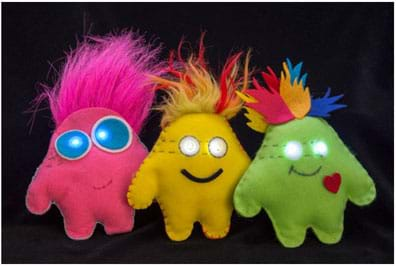
Engineering Connection
Engineers often use control units like microcontrollers to govern individual system components. These units contain embedded applications, which are relatively simple programs pre-loaded onto the control unit. In this way, they are different from microprocessor units, which are made to accept frequent user inputs.
Microcontrollers are used in many products, including automobiles, medical devices and home appliances. They typically enable limited control over a system, but consume less power and space than other control devices.
The LilyPad microcontroller used in this activity is specifically designed to be sewn into fabrics like clothing and toys by using conductive thread rather than conventional metallic wires. In this activity, LilyPad’s pre-programmed sequences are exploited to generate lighting patterns for LEDs incorporated into the plush toys students make.
Learning Objectives
After this activity, students should be able to:
- Assemble a system based on the LilyPad microcontroller.
- Describe what microcontrollers do.
- Explain why control units are important in engineering applications.
- Identify microcontroller applications.
Educational Standards
Each TeachEngineering lesson or activity is correlated to one or more K-12 science,
technology, engineering or math (STEM) educational standards.
All 100,000+ K-12 STEM standards covered in TeachEngineering are collected, maintained and packaged by the Achievement Standards Network (ASN),
a project of D2L (www.achievementstandards.org).
In the ASN, standards are hierarchically structured: first by source; e.g., by state; within source by type; e.g., science or mathematics;
within type by subtype, then by grade, etc.
Each TeachEngineering lesson or activity is correlated to one or more K-12 science, technology, engineering or math (STEM) educational standards.
All 100,000+ K-12 STEM standards covered in TeachEngineering are collected, maintained and packaged by the Achievement Standards Network (ASN), a project of D2L (www.achievementstandards.org).
In the ASN, standards are hierarchically structured: first by source; e.g., by state; within source by type; e.g., science or mathematics; within type by subtype, then by grade, etc.
NGSS: Next Generation Science Standards - Science
-
CCC.4.3-5.2.
A system can be described in terms of its components and their interactions.
(Grades 3 - 5)
More Details
Do you agree with this alignment?
-
DCI.PS3.B.3-5.3.
Energy can also be transferred from place to place by electric currents, which can then be used locally to produce motion, sound, heat, or light. The currents may have been produced to begin with by transforming the energy of motion into electrical energy.
(Grade 4)
More Details
Do you agree with this alignment?
International Technology and Engineering Educators Association - Technology
-
Follow directions to complete a technological task.
(Grades
3 -
5)
More Details
Do you agree with this alignment?
State Standards
Colorado - Science
-
Show that electricity in circuits requires a complete loop through which current can pass
(Grade
4)
More Details
Do you agree with this alignment?
Materials List
Each student needs:
- 1 LilyTiny microcontroller; such as from SparkFun for $5 at https://www.sparkfun.com/products/10899?_ga=1.37861539.1473012636.1478227346
- LilyPad coin cell battery holder, switched, 20 mm; such as from SparkFun for $4 at https://www.sparkfun.com/products/13883
- 5 (or fewer) LilyPad white LEDs; such as this pack of five for $4 from SparkFun at https://www.sparkfun.com/products/13902
- sewing needle; such as from this set of five needles for $2 from SparkFun at https://www.sparkfun.com/products/10405
- 4 alligator-style test leads; such as from this multicolored pack of 10 for $3 from SparkFun at https://www.sparkfun.com/products/12978
- 20-mm coin cell battery; such as CR2032 for $2 from SparkFun at https://www.sparkfun.com/products/338
- Monster Template
- craft felt, one 9 x 12-inch sheet makes one monster
To share with the entire class:
- conductive thread, 2 feet per toy/student; such as from the 30-ft stainless steel thread bobbin for $3 from SparkFun at https://www.sparkfun.com/products/10867
- stuffing for monster toy, such as fiber fill, cotton batting, cotton balls, fabric scraps, etc.
- hot glue gun(s) and hot glue sticks, for placement of components
- scissors
- sewing thread (non-conductive), such as nylon, cotton or embroidery
- (optional) assorted craft supplies for decoration, such as faux fur, feathers, sequins, fabric paint, glitter glue, paint pens, beads and buttons
Introduction/Motivation
How do we control systems? Often, we can control systems directly with a computer or microprocessor that is guided by user inputs and data. This enables us to direct a system with a wide range of instructions. However, for more simple systems that require less user input, engineers often elect to employ control devices known as “microcontrollers.”
Think of a microcontroller as a simpler version of a microprocessor, one that relies on embedded applications rather than being controlled by a user. Microcontrollers are great assets to engineers in the design process. For what purposes and products do you think engineers have used microcontrollers? (Discuss ideas as a class.) You’ll find them designed into everything from automobiles to home appliances. They can greatly simplify the design of a system, enabling end users to easily control an otherwise complex system. They also can provide great savings when it comes to space and energy consumption.
Electronic components are increasingly used in textiles, fashion and toys. Can you think of any that you have seen? (Listen to student responses.) Some examples are light-up shoes, shirts that play music, and stuffed animals that talk and sing. What powers and controls these engaging objects? From simple electrical components like batteries and relays, the technology has evolved to include microcontrollers, LEDs and flexible electronics that can even go through the washing machine!
Today, you get to experiment with a simple microcontroller called the LilyTiny. It’s a smaller variant of the LilyPad board that has less functionality. This microcontroller is specially designed for use with fabrics and textiles. It is intended to be sewn into materials using special conductive thread that creates circuits, rather than stiff, conventional metallic wire. Let’s get started!

Procedure
Background
If unfamiliar with e-textiles, take a look at the following SparkFun tutorials:
- E-Textiles Basics
- Sewing with Conductive Thread
- LDK Experiment 2: Multiple LED Circuits
- LDK Experiment 6: Microcontroller Circuits
Before the Activity
- Gather materials and make copies of the Monster Template.
- Pre-heat the hot glue guns.
With the Students
- Present to the class the Introduction/Motivation content to introduce the project. Incorporate the pre-activity assessment—a discussion of microcontrollers—into the session.
- Hand out to students the felt, scissors and template sheets.
- Direct the students to begin the project by cutting out the template shape from the felt sheet. This can be done by overlaying the template on the felt and cutting along the lines. The template is all one piece that folds for easy assembly. Alert students to make sure they do not cut the template into two separate pieces! Cutting it in half complicates the assembly.
- Hand out to each student a LilyTiny microcontroller and battery holder. Have students arrange the LilyTiny and battery holder on the felt cutout as shown in Figure 1. Tell students to be sure that the negative and positive pins on both components are facing each other when placed on the felt.
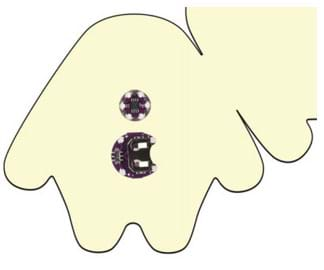
- Then use a very small amount of hot glue to tack the components in place on the felt. This is not the primary fastening method, so advise students not to use too much hot glue.
- Then have students use needle and conductive thread to connect the power supply to the LilyTiny board (create a circuit). Begin by threading a needle with about 12 inches of conductive thread and knotting it at the end. Then make two or three loops around the positive pin of the battery holder nearest the LilyTiny, sewing it to the felt as shown in Figure 2.
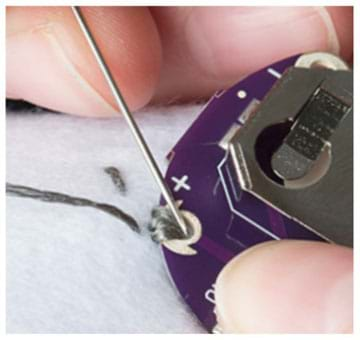
- Then continue to stitch across the felt towards the positive pin on the LilyTiny. When reached, make two or three thread loops to connect it to the felt in the same manner as was done for the battery holder. Then knot off the thread at the pin and cut off any excess thread. Refer to Figure 3.
- Repeat this step for the negative pins, so that their circuits looks like the black dashed line shown in Figure 3.
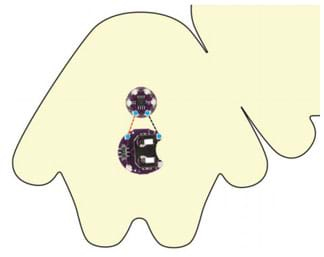
- Next, students test and then choose the light pattern(s) they want for their monsters. Each numbered pin of the LilyTiny is pre-programmed with a different light effect; the options are: random twinkle, blink, heartbeat and breathing (see Figure 4).
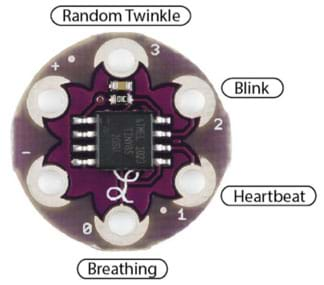
- To test, use two alligator clips to temporarily connect an LED to the LilyTiny, trying each numbered hole to observe the available lighting patterns. A battery must be inserted into the battery holder for the test to work. Refer to Figure 5 for how to use an LED and two alligator clips to make a testing circuit. See Figure 6 for the correct way to attach alligator clips to the LED pins. Follow these steps:
- Use an alligator clip (the black one in Figure 5) to attach the negative side of the LED to one of the negative pins on the battery holder. If the sewn one is too hard to grab with the clip, try the battery holder’s other negative pin.
- Use another alligator clip (the red one in Figure 5) to connect the positive end of the LED to one of the numbered pins on the TinyLily.
- Once everything is hooked up, insert a battery into the battery holder and turn the slide switch to ON. Expect to see a light pattern begin on the LED.
- To explore the other patterns, carefully detach the end of the clip attached to a LilyTiny numbered hole and move it to another one, until you have seen all the patterns.
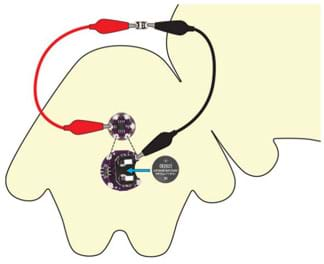
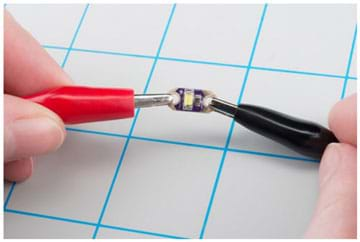
- Let students individually determine where on their monster templates they want to place the LEDs. For example, it works well to use two LED for eyes, however permit students to place the LEDs anywhere they want as long as they are all on the opposite piece of the felt template as the battery/board, as shown in Figure 7. Orient the LEDs so the negative sides are pointing downwards (to the monster’s feet) and the positive sides point upwards (to the monster’s head). Once students have determined the LED locations, have them use very small amounts of hot glue to tack the LEDs in place. Again, the glue is not the primary fastening method. Be sure students do not get hot glue inside the LED pin holes.
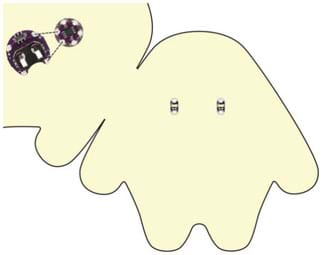
- Next, direct students to use conductive thread to connect the LEDs to the LilyTiny circuit. IMPORTANT: Remove the battery from its holder before beginning this step.
- Refer to Figure 8 for examples of completed circuits. The one on the left has two LEDs hooked up to the random twinkle pattern; the one on the right hooks up each LED to a different light pattern on the LilyTiny. Have students think through their LED lighting plans before sewing.
- Starting at the student-chosen LilyTiny sequence pin, sew two or three loops of thread around the pin and into the felt, then make neat stitches across the felt to the positive LED pin. Then loop the thread two or three times through that pin before knotting and cutting the thread OR continue stitching to the next LED if wanting it to be controlled by the same light sequence.
- Repeat this step for the negative pin on the battery holder and the LED negative pins. Keep the stitching away from other stitching so they don’t accidently touch.
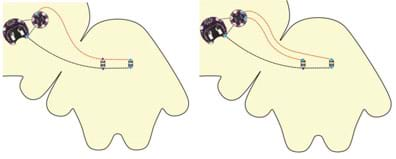
- Once the circuit is sewn, place a battery in the battery holder and test the circuit.
- Before the next sewing step, turn OFF the battery switch and remove the battery. Direct students to sew up and stuff their toys, as well as add any desired embellishments to give their monsters some personality.
- To sew the outer seam, fold the felt template so that the LEDs and LilyTiny are on the outside of the doll (so they remain accessible). Then use non-conductive thread to sew around the outer seam, as shown in Figure 9. Make sure to leave a one to two-inch opening in the outer seam in order to stuff the toy.
- Embellishments might include sewing designs and added bits and pieces onto the felt, like white felt circles over LED eyes, eye lashes, eye brows, mouths, noses, hearts and hair. Let students decide whether it makes more sense to add certain embellishments before or after sewing up the outer seam and stuffing the toy.
- After stuffing is complete, stitch up the remainder of the outer seam. Then knot and clip the thread. Mention that the fill also provides some insulation so the conductive thread on the two sides do not touch each other and cause a short circuit.
- When done, slip in a battery and switch to ON.
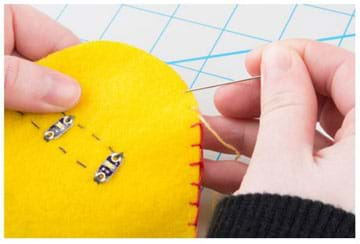
- Conclude by giving student a chance to show off their completed light-up monster toys to the rest of the class, as described in the Assessment section.
Vocabulary/Definitions
conductive thread: Thread spun of stainless steel (or silver-coated nylon) that carries current like wires so that it can be used to create circuits that are flexible and require no soldering and thus are suitable for textile-based projects that use embedded electronics. Conductive thread tends to be more “twisty,” and so more difficult to sew with than non-conductive (regular) thread.
e-textiles: Clothing or accessories that includes electrical components such as LEDs.
LED: Abbreviation for light-emitting diode, which is a type of semiconductor called a diode that converts electrical energy into light.
microcontroller: A small computer on a single chip, used for running embedded applications that control system components. Source: Wikipedia
microprocessor: A processor that incorporates the function of a central processing unit (CPU) on a single integrated circuit (IC). Source: Wikipedia
Assessment
Pre-Activity Assessment
Discussion: Discuss the topic of microcontrollers with the class. Have students think of and consider engineering applications in which microcontrollers might be used or could be useful. Students reveal their depth of understanding of microcontrollers through their discussion contributions.
Activity Embedded Assessment
Experimenting: Have students try different combinations of lighting sequences for each LED; doing this requires students to create individual circuits for each LED rather than one circuit with two parallel LEDs. Ask students to experiment with and explain what happens when they connect LEDs in series versus parallel configurations.
Post-Activity Assessment
Show-n-Tell: Give students a chance show off their completed plush toys and compare what they did with other student designs. How different are the designs? What are some advantages and disadvantages to the way other students designed their toys?
Take It Further: Have students think of additional textile-based projects in which they could employ TinyLily components to enhance the overall end products. Besides LEDs, what else could be attached to the TinyLily? Students’ answers reveal their comprehension of the activity concepts and technology.
Safety Issues
- Sharp sewing needles can cause injury if used carelessly. Advise students to use them with intention and be especially careful around their faces and eyes.
- Hot glue can cause minor burns so advise students to be deliberate and careful when using hot glue guns.
Troubleshooting Tips
Watch that the conductive thread is not shorted out by metallic surfaces or sloppy stitches during testing and operation.
Activity Scaling
- For lower grades, use fewer LDCs and minimize the amount of sewing require, perhaps by using hot glue to close up seams rather than needle and thread. Also consider partially assembling the LilyTiny system for students in advance of the activity.
- For higher grades, require students to use more LEDs and multiple lighting patterns. Also consider using a full-scale LilyPad board and having students upload their own sketches, rather than using the default sequences programmed into the LilyTiny.
Additional Multimedia Support
Sewing guides:
- See clear steps with photographs at the Hand Sewing: Thread the Needle & Tie the Knot website at http://www.sew4home.com/tips-resources/sewing-tips-tricks/hand-sewing-thread-needle-tie-knot
- Instructions on how to make seven different stitches at the Hand Stitching Basics website—basting stitch, running stitch, backstitch, overcast stitch, slipstitch/ladder stitch, blind hem stitch and securing stitch—at http://www.sew4home.com/tips-resources/sewing-tips-tricks/hand-stitching-basics
Subscribe
Get the inside scoop on all things TeachEngineering such as new site features, curriculum updates, video releases, and more by signing up for our newsletter!More Curriculum Like This

Students make design decisions about controlling LEDs in a light-up, e-textile circuit, plush toy project made using LilyPad ProtoSnap components and conductive thread. They follow instructions to assemble a product while applying their own creativity to customize it. In this sewable electronics pro...

Students learn the functions of pre-programmed microcontroller units such as the LilyMini ProtoSnap as they use them to create light-up pennants with LED components. Students design their own felt pennants and sew on circuit components using conductive thread.
References
Activity adapted from SparkFun’s LilyTiny Plush Monster activity at https://learn.sparkfun.com/tutorials/lilytiny-plush-monster?_ga=1.66649262.1473012636.1478227346
Osborne, Adam. An Introduction to Microcomputers. Volume 1: Basic Concepts (Second edition). Berkeley, CA: Osborne-McGraw Hill, 1980.
Copyright
© 2017 by Regents of the University of Colorado; original © 2014 SparkFun EducationContributors
Angela Sheehan; Aaron LamplughSupporting Program
SparkFun EducationLast modified: July 3, 2025







User Comments & Tips